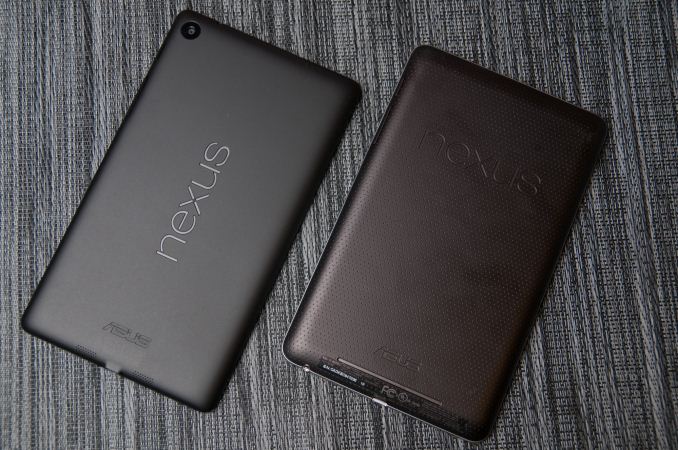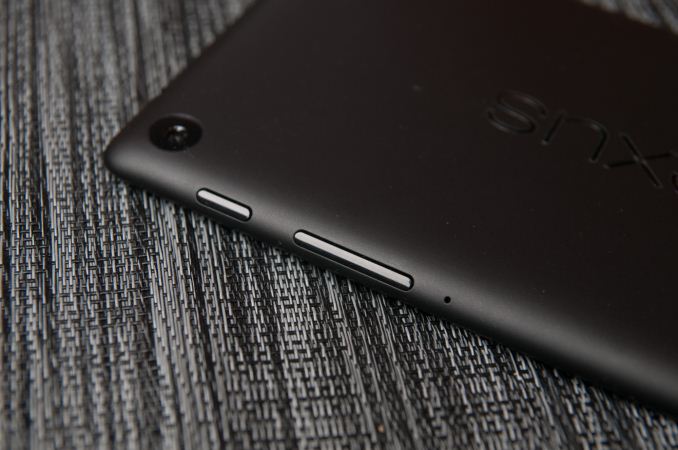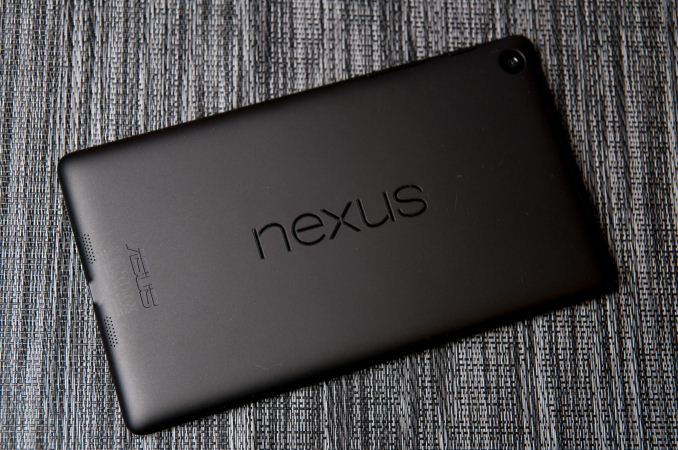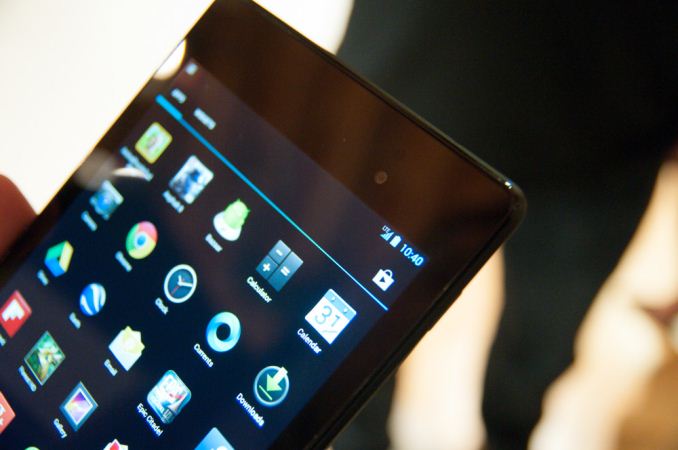Nexus 7 (2013) - Mini Review
by Brian Klug on July 27, 2013 12:54 AM EST- Posted in
- Tablets
- Snapdragon
- Qualcomm
- Android
- Mobile
- APQ8064
- Nexus 7
- Android 4.3

At an event in San Francisco, Google announced an updated version of the popular Nexus 7 tablet which first appeared at last year’s Google I/O. The big new features update the Nexus 7 platform with inclusion of a 1.5 GHz Snapdragon S4 Pro (APQ8064) SoC, 1920x1200 display by JDI (Japan Display Inc), as well as 5 MP rear facing camera, 1.2 MP front facing camera, stereo speakers, dual band WiFI, wireless charging (Qi) and a thinner and lighter chassis. It’s a major update that keeps the competitive price point that made the original Nexus 7 appealing (the lineup starts at $229 for the 16 GB model) while bringing numerous much-needed improvements that people have asked for.
First off, it’s shocking how much of a difference the change in thickness and weight makes. The new Nexus 7 feels considerably lighter and thinner in the hand than its older counterpart. Gone is the textured rubberized (almost driver glove-like) material on the back, in its place a flat, uniform soft touch material. There’s Nexus emblazoned in landscape on the rear, which is a bit puzzling next to the 90 degree rotated ASUS down below. It irritates my OCD sensibilities seeing the two logos inexplicably perpendicular and right next to each other, but I suppose Google thinks this helps emphasize how much the Nexus 7 and Android platform are really tablet-friendly now, with landscape view support throughout the core apps.
The rear facing camera is in the extreme top left, next to the power and volume rocker buttons, and top speaker. The Nexus 7 build and finish does feel a bit more plasticky to me this time around, but that’s almost expected given the price point, and it isn’t a major dig on the hardware at all. That’s not to say it isn’t sturdy or well put together, but just that the original Nexus 7 left a stronger impression on me last time, and I’ve been spoiled by the ASUS FonePad since then. The edge chamfer also helps the Nexus 7 feel a bit more like the Nexus 4 with its rounded edge. The previous Nexus 7 came to a point that could be a bit sharp at times.
What’s a little awkward is how tall the bezel at top and bottom looks on the Nexus 7, I’m warming up to it. On paper the new Nexus 7 is smaller in almost every dimension, in reality the elongated aspect ratio is definitely a bit pronounced here. There’s also still a notification LED well hidden under the glass at bottom in the center.
On the back is the new 5 MP rear facing camera, buttons (which hug the edges), a microphone port, and speakers. The speakers fire out the back of the Nexus 7 and look like they have good separation (obviously the best that the device’s size affords – top and bottom), but I don’t have a good feel for just how loud they go quite yet. Having stereo is a dramatic improvement for the audio part of video and multimedia consumption, and Android does 5.1 virtualization out the speakers as well. On the connectivity side of things there’s microUSB at the bottom with SlimPort video out, and a 3.5mm audio jack. I know a lot of people were hoping for inclusion of line in on the 3.5mm audio jack but I can confirm it isn’t present.
| Nexus 7Tablet Specification Comparison | ||||
| ASUS Nexus 7 (2012) | ASUS Nexus 7 (2013) | |||
| Dimensions | 198.5 x 120 x 10.45mm | 200 x 114 x 8.65mm | ||
| Chassis | Plastic + Rubber back | Plastic + Soft Touch back | ||
| Display | 7-inch 1280x800 IPS | 7.02-inch 1920x1200 IPS | ||
| Weight | 340 g | 290 grams (WiFi), 299 grams (LTE) | ||
| Processor | 1.3 GHz NVIDIA Tegra 3 (T30L - 4 x Cortex A9) | 1.5 GHz Qualcomm Snapdragon S4 Pro (APQ8064) | ||
| Memory | 1 GB | 2 GB DDR3L | ||
| Storage | 8 GB / 16 GB | 16 GB / 32 GB | ||
| Battery | 16 Whr | 15.01 Whr | ||
| WiFi/Connectivity | 802.11b/g/n, BT, NFC | 802.11a/b/g/n, BT 4.0, NFC | ||
| Camera | – |
5.0 MP Rear Facing w/AF 1.2MP Front Facing |
||
| Wireless Charging | – | Yes (Qi Compatible) | ||
| Pricing | $199/$249 |
$229/$269 (WiFi 16/32 GB) $349 (LTE) |
||
My only real complaint with the new Nexus 7’s in hand feel and build is with the power button and volume rocker, which feel somewhat mushy to me. I had issues taking screenshots even at times. It’s a minor gripe, but with only three buttons on the whole device, and generally good execution by ASUS with buttons on tablets, it surprised me. I guess I also do miss that racing glove-inspired texture in the soft touch on the back of the original Nexus 7.
| Nexus 7 (LTE) Band Coverage | |||||
| Model | GSM/EDGE Bands |
WCDMA Bands (HSPA+ 42) |
LTE Bands (UE Category 3) |
||
| North America Nexus 7 LTE |
Quad Band (850 / 900 / 1800 / 1900 MHz) |
HSPA+: 850/900/1900/2100/AWS(1700/2100) MHz (Bands: 1/2/4/5/8) | 700/750/850/1700/1900/2100 MHz (Bands: 1/2/4/5/13/17) | ||
| Europe Nexus 7 LTE | 800/850/1700/1800/1900/2100/2600 MHz (Bands: 1/2/3/4/5/7/20) | ||||
There’s a version of the Nexus 7 with 32 GB of storage and LTE onboard for $349 which will appear ‘in the coming weeks’ and includes support for AT&T, T-Mobile, and Verizon LTE in the USA on one piece of hardware. This is the first single SKU solution I’m aware of with coexistence of Bands 13 and 17 (Verizon and AT&T respectively) on the same device, which is awesome. There’s a model with Bands 3, 7, and 20 for Europe as well, so they’re not left out of the LTE fray. I had a chance to quickly get a look at the new Nexus 7 with LTE, which includes a microSIM tray and was working on one of the LTE networks in San Francisco just fine.
As far as I know, the Nexus 7 LTE solution is Qualcomm’s MDM9215 with a WTR1605L transceiver inside, and doesn’t necessarily include any of the new RF360 brand of front end hardware (like the power amplifier with integrated antenna switch or tunable front end), since MDM9x15 only works with QFE1320 (Bands 1,2,3/4,5,8,20). Still, that makes it all the more impressive, and Google deserves considerable kudos for further pushing such unprecedented interoperability, since in a tablet you do have more area to include discrete power amplifiers and filters.




















252 Comments
View All Comments
jjj - Saturday, July 27, 2013 - link
Still no microSD so not touching it but the really sad part is that this is the best and will most likely remain the best small Android tablet since everybody is focusing on budget. There is plenty of room for better specs but somehow i doubt we'll see such a product. Google should have made a high end model too,nobody else does it. Android for small tablets shouldn't be upper mid-range (like the new Nexus) or less. Everybody is making Android tablets nowadays and somehow they don't manage to cover all sizes and market segments. It's fantastic that there are decent 7 inchers at 100$ but it would also be great if there was a 7 inch tablet that's not missing anything - and that goes for all sizes.It's also nice to see that screen , such screens getting cheap enough will enable a nicer Oculus Rift :D
aNYthing24 - Saturday, July 27, 2013 - link
This is ridiculous. How many tablets do know that have replaceable memory and replaceable batteries?nerd1 - Saturday, July 27, 2013 - link
Most android tablets have micro sd slots. That said, I just dont have enough excuses not to buy this one...sherlockwing - Saturday, July 27, 2013 - link
Unfourtatedly I have to pass on this one, my Video library is 40GB+ so the lack of a 64GB model or a micro SD slot kills it for me.Sunburn74 - Saturday, July 27, 2013 - link
You watch all 40gb on a daily basis? This is a mobile device, not a media server.Broo2 - Saturday, July 27, 2013 - link
You have 40GB of videos that you like to watch on a re-occurring basis? or is the 40GB a collection of movies you have purchased that you may want to watch again? (i.e. a digital version of a shelf of DVD/Blu-Ray movies.)mr_tawan - Saturday, July 27, 2013 - link
You can just install the custom rom, plug-in a card reader in with the OTG cable. Then you can plug your media card (even CF).Well I would say setting up a media server is a lot more convenience.
Impulses - Sunday, July 28, 2013 - link
You don't even need root to use USB OTG (at least not with the original Nexus 7), much less a custom ROM, just an app... And USB OTG is far more versatile in general since you can hook up fast USB 3.0 flash drives that way, if you actually need tons of storage then you're also transferring tons of content from a PC and USB 3.0 helps immensely with that (microSD cards can't touch the 200MB/s speed of some of the cheap drives out there).I fail to see the usage case for card slots that can't be satisfied by USB OTG.
leomax999 - Sunday, July 28, 2013 - link
Would you rather carry a usb thumb drive,cables and adapters everywhere or have a microSD card in its slot?Let's try to break down. Assuming 32Gig Nexus has ~27Gigs of free space.
Couple of 1080p movies + videos = ~12G
A bit of music, Say ~10G
Some pictures ~1G
Applications + Games (No offline Maps,No big games!) ~2G
Which leaves you about 2Gig of free space which is a bit too full for flash performance, without counting any other space required for app data/cache etc.
The new Nexus is a good upgrade,But google has yet to sort the storage.
deathgod1 - Saturday, July 27, 2013 - link
I'm with you on the micro SD. I currently have a Tranformer Infinity 32GB with a 32GB SDcard and I'm constantly having to delete items off both to free up space. I don't live in a country where wifi is everywhere (or where streaming options are offered), so I keep all my media on my tab. That includes app backups with Titanium, backups of the ROM i'm using, nandroid backups, movies, music, music videos, pictures,books, comics, etc. HD games like NOVA are several GB's in size. It's really easy to run out of space if you're a media centric person like me. My tablet has basically replaced my laptop, but I guess I'm in the minority of people.